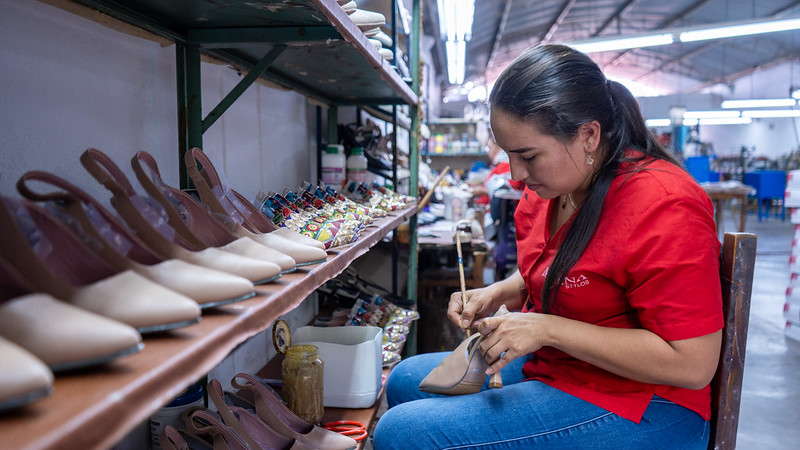Competitiveness: Between the Urgent and the Everyday / Column by Ana Fernanda Maiguashca

2025 has been a year marked by profound political and economic volatility globally. Ongoing international conflicts, geopolitical polarization, and escalating protectionism in global trade have somewhat thwarted the nascent trends of economic recovery in the post-pandemic period.
According to the IMF's latest World Economic Outlook (2025), global economic growth is expected to reach 2.8% for this year, 0.5 percentage points lower than the January forecast. The WTO (2025) estimates that, as a result of the trade measures imposed by the United States , global trade will decline by approximately 0.2% in 2025.
The country is not facing this situation with any particular strength in terms of competitiveness. The index that currently allows us to comprehensively compare competitiveness factors with the rest of the world is the World Competitiveness Index, developed by the IMD for 37 years. In this index, Colombia will rank 54th out of 69 countries in 2025, registering a score of 49.66 on a scale of 0 to 100.
The country is ranked third among Latin American countries, after Chile (42nd) and Puerto Rico (45) , and ahead of Mexico (55), Brazil (58), Peru (60), Argentina (62) and Venezuela (69), the only countries in the region evaluated in the measurement.
This index reflects some of the symptoms of those areas where we historically see our weaknesses. In the Government Efficiency pillar, and specifically in the Institutional Framework, Business Legislation, and Social Framework components, we rank 59th, 60th, and 67th, respectively.
In the Business Efficiency factor, its greatest challenges are concentrated in the pillars of Productivity and efficiency (position 60) and Finance (63), while in the Infrastructure factor, these are observed in the pillars of Scientific Infrastructure and Education, where it is located in position 59.
When we stop comparing ourselves to the world and look at our regional competitiveness indicators, the picture is the same: a multitude of symptoms that reflect enormous challenges and vast gaps between our regions. The CPC, in partnership with the Universidad del Rosario, develops the Departmental Competitiveness Index (DCI), a measurement that illustrates this phenomenon for Colombia's 32 departments and the city of Bogotá, using 98 indicators. Examining DCI data from the last seven years, we find that the average score for the 13 pillars we measure is 4.7—on a scale of 0 to 10—for the 33 territories evaluated.

Wide-angle view of Bogotá, Colombia's capital. Photo: iStock
Additionally, we found that while the highest-ranked region in 2025, Bogotá, scored 8.1, the lowest-performing department, Vichada, barely reached 2.5 . In pillars such as innovation, the gap is not only between the last-ranked department and the second-ranked department: Bogotá recorded a score of 7.4, while Antioquia obtained 5.3, representing a difference of 2.1 points. In total, 21 departments had scores equal to or lower than 3 out of 10 in this pillar.
Perhaps worth highlighting is the progress made by all of the country's departments in terms of competitiveness between 2019 and 2025. All 33 territories evaluated showed an increase in their overall score compared to seven years ago.
Regarding the areas assessed by the IDC, the greatest disparities between departments were found in areas related to ICT adoption, the financial system, sophistication and diversification, and innovation. In these cases, the difference between the best and worst performers was greater than 7.5 points on a scale of 0 to 10. Among the indicators with the largest gaps were fixed internet bandwidth, savings accounts, diversification of the export basket, and researchers per capita.
The disparity in capabilities results in differentiated competitive strategies, which is encouraging in terms of product diversification and innovative initiatives. Approximately 20% of the national manufacturing GDP is generated in the Antioquia region and the coffee-growing region, while nearly 50% of the mining GDP is produced in the Llanos and Orinoquía regions. Regarding employment, approximately 20% of the employed population in the central region works in the social, community, and personal services sector, while more than a third of the employed population in the Amazon is employed in the agricultural sector. However, these strategies do not produce results that allow them to close the social gaps between the different departments.
In 2024, while 5.4% of Bogotá's population lived in multidimensional poverty, in contrast, this proportion reached 70.2% in the department of Vichada (DANE, 2025). Bogotá's population density is clearly much higher than that of Vichada as a whole, but these results illustrate how a significant portion of the territory offers no way out of poverty for its inhabitants.
The lack of certain capacities in the country and the marked differences between regions prevent us from increasing the productivity of our economy. If we do not make our efforts more productive, we will continue to fail to generate the income that a society with Colombia's characteristics needs to overcome poverty and enter a dynamic of sufficient and sustainable growth. The country's performance in terms of productivity has historically been low . The contribution of total factor productivity to economic growth over the last 20 years has been -0.2%. The growth we have experienced during this period came from investment in capital assets and an expanded labor force.

Ana Fernanda Maiguashca, president of the Private Competitiveness Council. Photo: Asobancaria
However, these factors do not offer an encouraging outlook in the current situation. In the case of investment, its share of GDP reached a record high of 23% between 2014 and 2015—before the global fall in oil prices. Since then, this figure has fallen to levels close to 17% in 2024.
For its part, the demographic transition is occurring at a faster rate than originally predicted by projections from the United Nations or DANE. According to DANE estimates, the Colombian population is expected to begin declining in 2052. Some exercises conducted by the Bank of the Republic show that, adding the impact of emigration and the recent slowdown in the birth rate, the decline could have begun as early as 2022 (Banrep, 2025).
This phenomenon, in particular, makes it crucial to have a strategy that allows us to attract higher levels of investment and increase factor productivity. However, often when we conduct this type of analysis, it's easy to fall into one of two extremes: one that tends to oversimplify the problem and choose a silver bullet that will solve all problems; and the other that, seeing the complexity of the problem of moving forward on several fronts simultaneously and, above all, accepting that many of the approaches only offer long-term returns, opts for paralysis. Neither of these two extremes offers us a way out.
Instead, we can think of some levers we could use if we give ourselves the chance to break out of the box and make bold bets that allow us to open paths to progress. These are neither the only relevant nor the only possible ones; they are a way of illustrating that we should be able to reach a minimum agreement that generates results that, in turn, generate enthusiasm for transformation.
Given the urgent need to recover and surpass current investment levels as a percentage of GDP, it is necessary to reflect on the major capital mobilization fronts that have driven the economy in the past. The mining and energy sectors and the infrastructure sector are two key examples. We must also consider the cross-cutting conditions that facilitate greater capital creation in the country.
Signs of exploration in the mining and energy sectors, both for gas and oil, are essential. Equally important is the sign of a credible fiscal adjustment path that reduces the cost of capital for all projects. Finally, it is necessary to consider replacing tax sources with those seeking resources from taxes on consumption rather than capital investment.
Energy potential, in turn, must take off, and therefore we will need to design an emergency plan to unblock the licensing process for the generation, connection, and transmission of various energy sources. Finally, we must pave the way for more private initiatives within the framework of public-private partnerships to bolster the transportation infrastructure sector.
In the education sector, it is possible to promote greater vocational training beginning in secondary education, allowing young people to enter trades within their educational institutions. Today, we face high dropout rates among this population; the challenge lies in ensuring they can generate some form of income and strengthen their human capital without dropping out of the education system.

SMEs Photo: MinCit
On the labor front, we must create a space for flexibility so that people who have partial working hours can make contributions to social security. Regarding the cost of formality, we must push ourselves to consider bold solutions: we must allow certain frameworks, such as the commercial registry and compensation funds, to seek financing schemes that do not burden the formality of the most vulnerable part of the production chain.
Finally , we need a productive sector that unites around productive projects to seek private drivers of development while public policy supports them. Today, there are already groups working on the fronts of nearshoring, construction, food production, energy, and financial inclusion. To the extent that we all commit to thinking about and promoting less conventional solutions than those adopted until now, we can open up new opportunities for those who have found a way to break their cycles of poverty in other economies. This is a path we must travel together as a society, one in which we must be more creative and flexible, since the conditions imposed by the world are taking away our ability to remain tied to our traditional model of gradual progress.
Visit the Private Competitiveness Council website: www.compite.com.co.
*Ana Fernanda Maiguashca, president of the Private Competitiveness Council.
eltiempo





